CBA’s chief economist, Gareth Aird, with the note:
Overview
For most of H1 21 Australia looked on track to live up to its namesake as “the lucky county”. Economic outcomes were strong, COVID-19 was by and large not circulating in the community and the vaccine rollout was moving forward, albeit slowly. We appeared very much on course to end the year with an unemployment rate of ~4.5% and the vast majority of the adult population vaccinated. Australian exceptionalism would once again shine and the world would look upon us with envious eyes and wonder how exactly we pulled it off.
That idyllic scenario, however, has not materialised and the economy has hit a major pothole before we’ve reached the vaccine finish line. The COVID-19 situation in NSW in particular has significantly altered the economic landscape in the near term. As a result, our economic forecasts for H2 21 have been sent to the shredder.
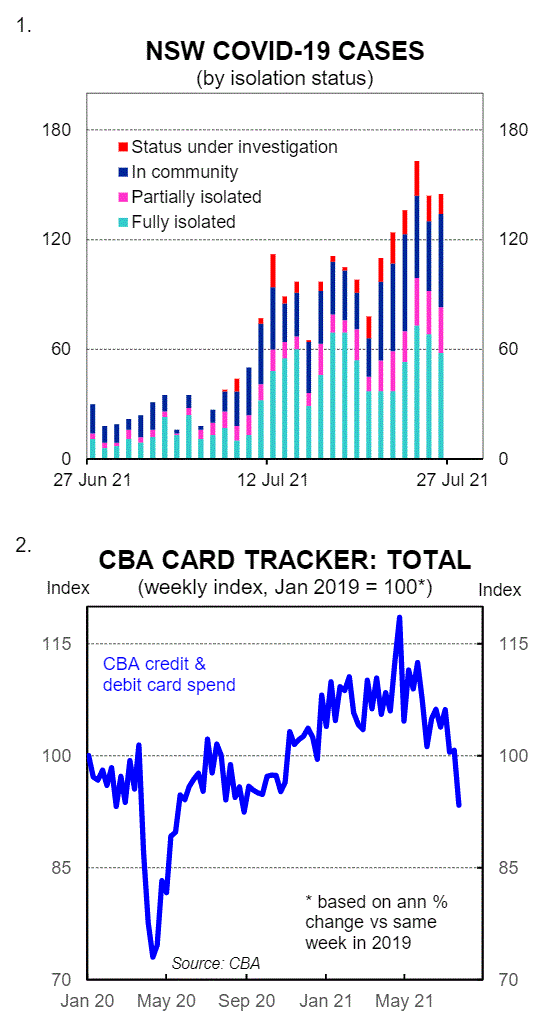
A deep contraction in GDP over Q3 21 is now a fait accompli. It is the inevitable consequence of shutting down large parts of the economy. Employment will fall and unemployment will rise. But outcomes across the country will vary greatly. The Australian economy will become two-speed. The NSW economy will contract heavily over Q3 21 as restrictions to limit the spread of the virus reduce the production of goods and services. In contrast, the rest of Australia is likely to expand modestly, subject of course to any further COVID-related distributions.
Substantial policy support will once again be needed to ensure that the economic rebound is swift when restrictions are eased. The recently announced fiscal support is significant, but wesuspect that policymakers will once again err on the side of doing too much rather than not enough and further stimulus is likely.
In this note we discuss our updated central scenario for the Australian economy and the RBA.
The vaccine rollout and our underpinning assumptions
The rollout of the vaccine is incredibly important for the economic outlook because at this juncture policymakers have sought to achieve herd immunity through vaccinations rather than exposure to the virus. As the new member of our team Stephen Wu wrote last week, we haven’t heard anything definitive from policymakers on what share of the population would need to be vaccinated to re-open borders and prevent lockdowns. But it appears that policymakers are targeting an 80% vaccination based on figures that experts and government officials have floated.
Our modelling indicates that it will take until at least late October before 80% of the 16+ population are vaccinated (charts 3 and 4). Our working assumption therefore is that Greater Sydney has a significant number of restrictions in place until the middle of Q4 21.
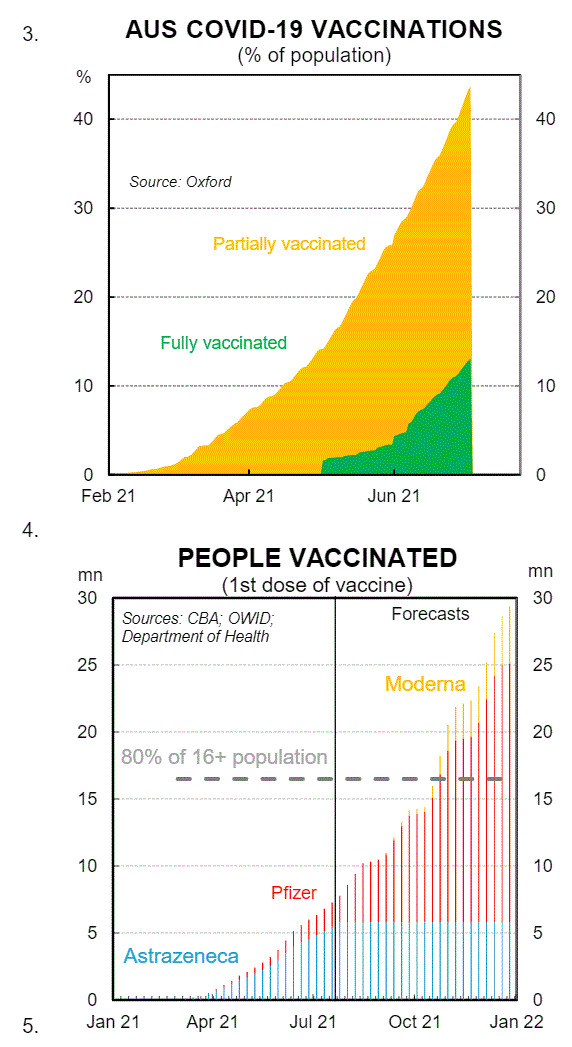
Whilst this seems like a worst case scenario, it is now our base case given the higher transmission rate of the delta strain. Put another way, new daily COVID-19 cases active in the community in NSW are unlikely to reach zero over an extended time period. Therefore, based on the NSW Government’s current reaction function, restrictions are only likely to be partially removed until a yet-to-be-determined vaccine threshold has been reached, which we put at 80%.
We assume that lockdowns in Victoria and South Australiaachievethe desired outcome and daily new COVID-19 cases active in the community do not resurface. Notwithstanding, there will be some lingering restrictions in Victoria that will weigh on economic in the near term activity. The risk remains that there are further snap lockdowns across the country until the vaccine threshold has been reached.
GDP in 2021
Greater Sydney’s contribution to GDP is estimated to be around 25% while the NSW economy is worth 32% of the national economy (chart 5). Based on our internal data on card spend and the recent experience with lockdowns, we estimate that once construction is turned back on each week of lockdown will shave ~$A1bn off GDP (0.2% of quarterly GDP).
We therefore expect NSW state final demand(SFD)to contract by a large~9%in Q3 21. The economy is forecast to modestly expand across the rest of Australia. As such, we forecast GDP to contract by 2.7% in Q3 21, following an expected0.6% increase in Q2 21. The weakness will largely be in household consumption. Our CBA card spend data highlights how services spend has already been hit hard over recent weeks (chart 6).
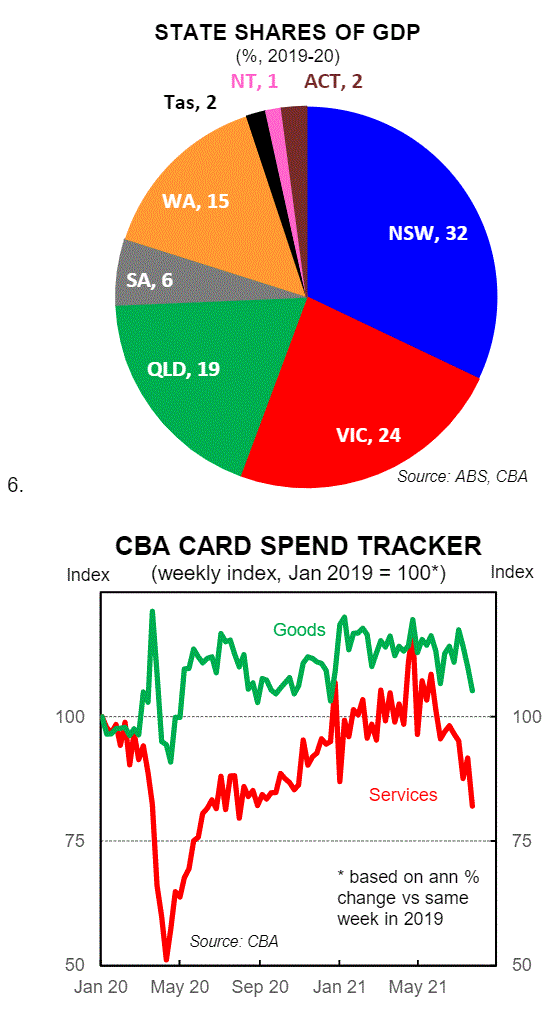
GDP growth should lift strongly in Q4 21 as restrictions in NSW are eased. However,on our figuring the bounce to economic activity will not come through until midway through the December quarter. This means that GDP will only partially rebound in Q4 21 from the large contraction anticipated in Q3 21 and we expect to end theyear with GDP lower than its forecast Q2 21 high.
We have pencilled in a lift in Q4 21 GDP of 1.9% that would on our figuring see GDP in the December quarter 0.9% below its Q2 21 level. The economy is expected to be above the Q2 21 level of GDP in Q122.
The labour market in 2021
Around 22% of the national workforce is employed in Greater Sydney. Over April and May 2020 when Australia went into a national lockdown, employment in Greater Sydney fell by 200k. Over the same period unemployment rose by a much smaller 50k (chart 7). The difference between the much larger declinein employment relative to the increase in unemployment is reconciled by the sharp fall in the participation rate. Most workers stood down because of a lockdown do not look for another job while in lockdown. It should be noted that JobKeeper was available to eligible businesses in April and May 2020, when the big contraction in employment occurred.
Our expectation is that in the absence of another JobKeeper style program the contraction in employment will be larger this time in Greater Sydney. And given the lockdown will go for longer than the lockdown last year we forecast employment to contract by ~300k in NSW (the bulk of the fall will be Greater Sydney but there will also be some job losses in the rest of NSW).
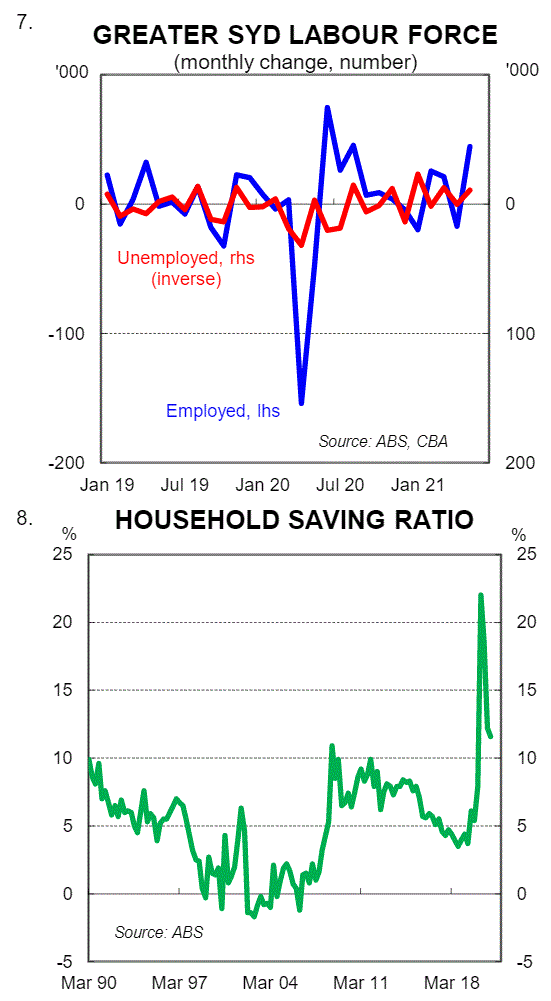
The significant majority of workers stood down in NSW will drop out of the labour force –there will simply be no jobs available for the vast majority of these workers. This means that the participation rate will fall and the rise in unemployment will be a lot more modest than the fall in employment(CBA expects an increase in unemployment of ~50k).
On our calculations the unemployment will peak at 5.6% in October.
The improvement in the labour market towards the end of the December quarter sees the unemployment rate at 5.2% at end-2021.
The economy in 2022
Despite the big negative setback, strong economic outcomes through the first half of 2021when COVID-related disruptions were pretty minimal give us an insight into what we can expect in 2022 when the economy has clear air from the virus recall that the unemployment rate was 4.9% in June).
The rapidly tightening labour market over H2 21 showed what can be achieved when fiscal and monetary policy are working in tandem and growth in labour market supply is contained. Put another way, policymakers have the blueprint to generate a tight labour market again.
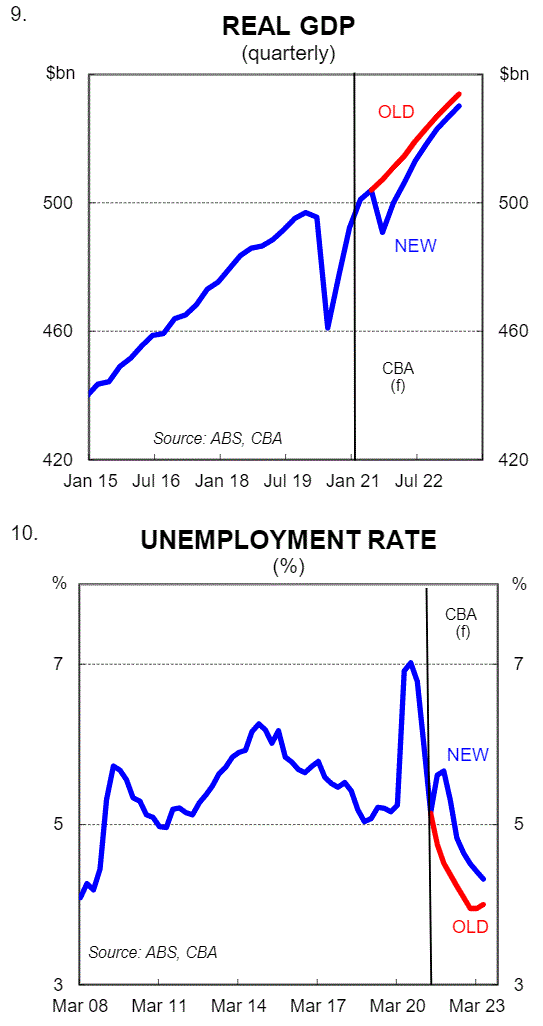
It is our expectation that 2022 will be an incredibly good year for the Australian economy-provided the successful rollout of the vaccine means that COVID-19 restrictions are no longer imposed on the domestic economy.
The RBA will continue to run exceptionally loose monetary policy while the 2021 Budget indicates fiscal settings will remain expansionary. The international border will reopen which will boost demand in the economy whilst growth in labour market supply is not expected to catapult back to its pre-COVID levels. In turn this will help the labour market to tighten quickly, which will enable wages growth to accelerate.
Households will be armed with an unprecedented war-chest of savings that will continue to accumulate over H2 21. Our forecastsfor household consumption and income over H2 21mean that the savings rate will increase from an already elevated level,which is likely to see additional savings accrue of ~$A60bn(chart 8). On our figuring this means that over the pandemic households will have put away $A200bn above and beyond what is normally saved (10% of GDP). Finally and importantly, next year households and businesses will be operating in an environment of less COVID-related uncertainty which will propel ‘animal spirits’ higher.
We forecast GDP to grow by 3.3% in 2022 following a 3.6% increase in 2021 (chart 9).
The unemployment rate is forecast to be 4.5% at end-2022 and to continue trending lower through 2023 (chart 10).
The RBA from here
Our call for the RBA to commence normalising the cash rate from November 2022 was predicated on the assumption that any outbreaks of COVID-19 were traced and well contained, and significant restrictions were not reimposed for an extended period. That assumption of course has not transpired. Indeed the number of daily COVID-19 cases in NSW began accelerating from the day that we published the RBA rate hike call on 23 June; Murphy’s law.
The negative shock to the economy, particularly the labour market, over the next few months will mean that it takes a little longer for wages pressures to fully emerge. There is still likely to be pockets of wages growth, but the big shock to the NSW labour market will have an impact on national outcomes. We have downwardly revised our forecast profile for wages growth and now look for wages growth to be 2.7%/yr at end-2022 (vs 2.9% previously). This means that a tightening cycle is unlikely to commence until 2023.
Our central scenario now has the RBA delivering the first hike in the cash rate in May 2023. We have pencilled in an increase of 15bp, which would take the cash rate to 0.25%. We expect that to be followed by an increase of 25bp in June 2023. We have three further 25bp hikes in Q323, Q423 and Q124that would take the cash rate to 1.25%, the level at which we assess the cash rate to be neutral based on household debt servicing(charts 11, 12 and 13).
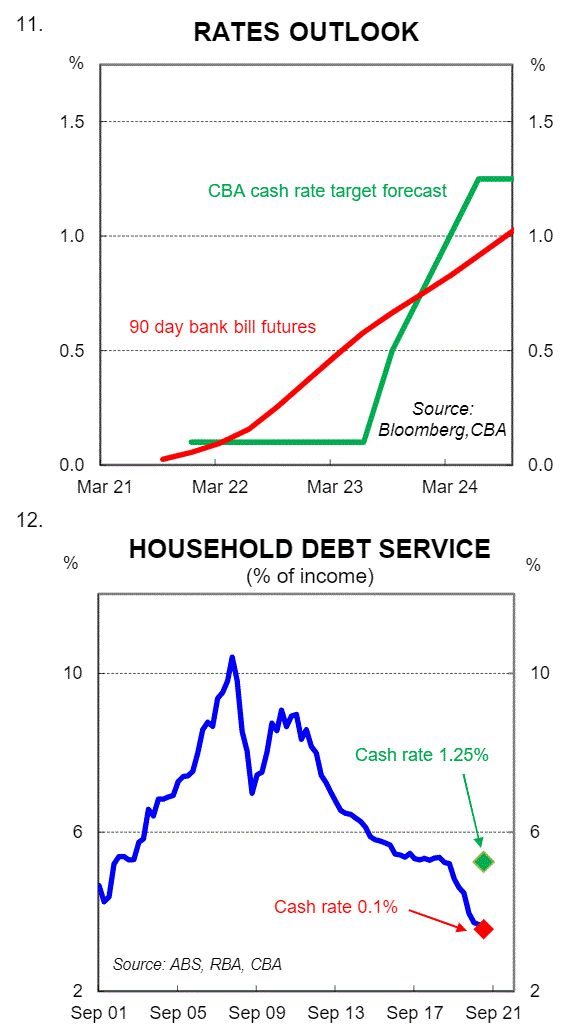
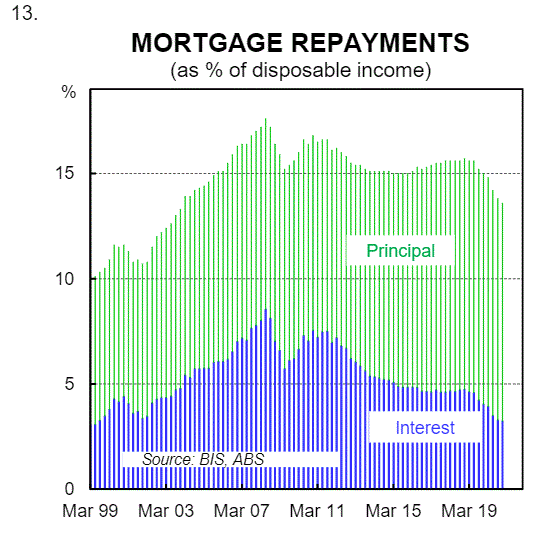
In summary, the pace of policy normalisation remains the same, but we have pushed out the start date by six months. We think that the risks to our call are evenly balanced. On the one hand a booming economy in 2022 could see the RBA pull the rate hike trigger before May 2023 if inflation and wages pressures emerge more quickly than is implied in our updated profile. On the other hand, if labour market supply starts to ramp up quickly with the reopening of the international border over H2 22 it could put some downward pressure on wages growth and make it more difficult for the RBA to achieve its objective of inflation sustainably within the target.
We updated our call on the RBA’s bond buying program last week (see here). We expect the RBA to reverse itsdecision to taper the bond buying program from mid-September and we expect that announcement to be made at the August Board meeting (3 August). The impact on the economy of buying bonds at a rate of $A4bn per week as opposed to $A5bn a week is negligible. But the optics of tapering when the national economy is contracting means a decision not to proceed with the already announced taper looks most likely.
There is a risk that the RBA scales up its bond purchases (i.e. shifts from $A5bn to $A6bn per week), but we believe that any such gesture would largely be symbolic. As such, our working assumption is that the Board will simply announce they will continue to purchase bonds at the current rate of $A5bn per week through to November.
We expect the RBA will continue buying bonds at a rate of $A5bn per week from November 2021 and do not expect them totaper until February 2022. Our profile sees them taper bond purchases a little more aggressively to$A3bn per week in February 2022. A further taper in May 2022 looks likely with bond purchases to be$A2bn until August. We have the cessation of quantitative easing pencilled in at August 2022. This profile would see QE3 total ~$A160bn.

